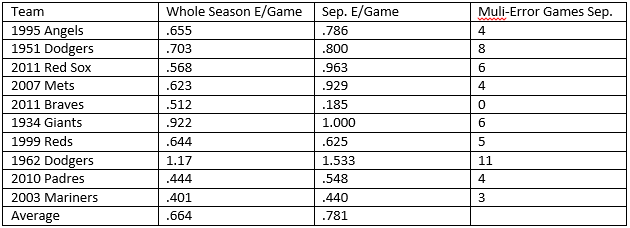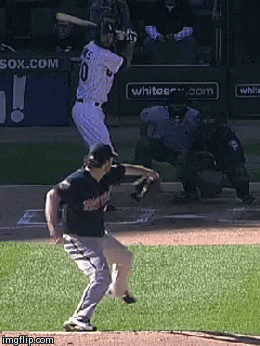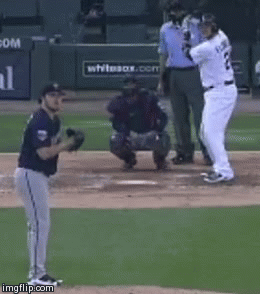Your One-Stop Shop for Postseason Narrative Debunking
I, like you, have been hearing and reading a lot about the postseason and which teams are best positioned to go deep into October. The rationales aren’t always based on more tangible factors — like, say, which teams are good — but rather on “hidden” or “insider” clues (use of scare quotes completely intentional) drawn from other qualities. I decided to test each of the factors I’ve heard or read about.
Full disclosure: This isn’t exactly original research. Well, it is, in that I made a list of various hypotheses to test, decided how to test them, and then spent hours pulling down data from Baseball-Reference and FanGraphs in order to create an unwieldy 275×23 spreadsheet full of logical operators. But it isn’t original in that some of the questions I’m addressing have been addressed elsewhere. For example, I’m going to consider whether postseason experience matters. David Gassko at the Hardball Times addressed the impact of players’ postseason experience on postseason outcomes in 2008, and Russell Carleton at Baseball Prospectus provided an analysis recently. I’m not claiming to be the first person to have thought of these items or of putting them to the test. What I’ve got here, though, is an attempt to combine a lot of narratives in one place, and to bring the research up to date through the 2013 postseason.
I’m going to look at seven questions:
- Does prior postseason experience matter?
- Do veteran players have an edge?
- How important is momentum leading into the postseason?
- Does good pitching stop good hitting?
- Are teams reliant on home runs at a disadvantage?
- Is having one or more ace starters an advantage?
For each question, I’ll present my research methodology and my results. Then, once I’ve presented all the conclusions, I’ll follow it up with a deeper discussion of my research methodology for those of you who care. (I imagine a lot of you do. This is, after all, FanGraphs.) In all cases, I’ve looked at every postseason series since the advent of the current Divisional Series-League Championship Series-World Series format in 1995. (I’m ignoring the wild card play-in/coin flip game.) That’s 19 years, seven series per year (four DS, 2 LCS, 1 WS), 133 series in total.
DOES POSTSEASON EXPERIENCE MATTER?
The Narrative: Teams that have been through the crucible of baseball’s postseason know what to expect and are better equipped to handle the pressures–national TV every game, zillions of reporters in the clubhouse, distant relations asking for tickets–than teams that haven’t been there before.
The Methodology: For each team, I checked the number of postseason series they played over the prior three years. The team with the most series was deemed the most experienced. If there was a tie, no team was more experienced. I also excluded series in which the more experienced team had just one postseason series under its belt, i.e., a Divisional Series elimination. I figured a team had to do more than one one-and-done in the past three years to qualify as experienced. In last year’s NLCS, for example, the Cardinals had played in five series over the past three years (three in 2011, two in 2012), while the Dodgers had played in none. So St. Louis got the nod. In the Dodgers’ prior Divisional Series, LA played an Atlanta team that lost a Divisional Series in 2010, its only postseason appearance in the prior three years, so neither team got credit for experience.
The Result: Narrative debunked. There have been 101 series in which one team was more experienced than the other, per my definition. The more experienced team won 50 of those series, or 49.5%. There is, at least since 1995, no relationship between postseason experience and success in the postseason.
DOES VETERAN PLAYERS HAVE AN EDGE?
The Narrative: The pressure on players grows exponentially in October. A veteran presence helps keep the clubhouse relaxed and helps players perform up to their capabilities, yet stay within themselves. Teams lacking that presence can play tight, trying to throw every pitch past the opposing batters and trying to hit a three-run homer with the bases empty on every at bat. (Sorry, I know, I’m laying it on thick, but that’s what you hear.)
The Methodology: For each team, I took the average of the batters’ weighted (by at bats + gamed played) age and the pitchers’ weighted (by 3 x games started + games + saves) age. I considered one team older than the other if its average age was 1.5 years older than that of its opponent. For example, in the 2012 ALCS, the Yankees’s average age was 31.5, and the Tigers’ was 28.1, so the Yankees had a veteran edge. When the Tigers advanced to the World Series against San Francisco, the Giants’ average age was 28.9, so neither team had an advantage.
The Result: Narrative in doubt. There have been 51 series in which one team’s average age was 1.5 or more years greater than the other. The older team won 27 of those series, or 53%. That’s not enough to make a definite call. And if you take away just one year–2009, when the aging Yankees took their most recent World Series–the percentage drops to 50%–no impact at all.
HOW IMPORTANT IS MOMENTUM LEADING INTO THE POSTSEASON?
The Narrative: Teams that end the year on a hot streak can carry that momentum right into the postseason. By contrast, a team that plays mediocre ball leading up to October develops bad habits, or forgets how to win, or something. (Sorry, but I have a really hard time with this one. We’re hearing it a lot this year–think of the hot Pirates or the cold A’s–but there are other teams, like the Orioles, who have the luxury of resting their players and lining up their starting rotation. I have a hard time believing that the O’s 3-3 record since Sept. 17 means anything.)
The Methodology: I looked up each team’s won-lost percentage over the last 30 days of the season and deemed a team as having more momentum if its winning percentage was 100 or more percentage points higher than that of its opponent. For example, in one of last year’s ALDS, the A’s were 19-8 (.704 winning percentage) over their last 30 days and the Tigers were 13-13 (.500), so the A’s had momentum. The Red Sox entered the other series on a 16-9 run (.640) and the Rays were 17-12 (.586), so neither team had an edge.
The Result: Narrative in doubt, and then, only for the Divisional Series. There have been 64 series in which one team’s winning percentage over its past 30 days was 100 percentage points higher than that of its opponent. In those series, the team with the better record won 33, or 51.5% of the time. That’s not much of an edge. And when you consider that a lot of those were in the Divisional Series, where the rules are slanted in favor of the better team (the team with the better record generally gets home field advantage), it goes away completely. Looking just at the ALCS, NLCS, and World Series, the team with the better record over the last 30 days of the season won 13 of 27 series, or 48%, debunking the narrative. In the Divisional Series, the hotter team over the last 30 days won 20 of 37 series, or 53%. That’s an edge, but not much of one.
DOES GOOD PITCHING STOP GOOD HITTING?
The Narrative: Pitching and defense win in October. Teams that hit a lot get shut down in the postseason.
The Methodology: I struggled with a methodology for this one. I came up with this: When a team whose hitting (measured by park-adjusted OPS) was 5% better than average faced a team whose pitching (by park-adjusted ERA) was 5% better than average, I deemed it as a good-hitting team meeting a good-pitching team. For example, the 2012 ALCS featured a good-hitting Yankees team (112 OPS+) against a good-pitching Tigers team (113 ERA+). The Yankees were also good-pitching (110 ERA+), but the Tigers weren’t good-hitting (103 OPS+).
The Result: Narrative in doubt. There have been 65 series in which a good-hitting team faced a good-pitching team, as defined above. (There were four in which both teams qualified as good-hitting and good-pitching; in those cases, I went with the better-hitting team for compiling my results.) In those series, the better-hitting team won 32 times, or 49%. That is, good hitting beat good pitching about half the time. That pretty much says it.
ARE TEAMS RELIANT AT HOME RUNS AT A DISADVANTAGE?
The Narrative: Teams that sit back and wait for home runs are at a disadvantage in the postseason, when better pitching makes run manufacture more important. Scrappy teams advance, sluggers go home.
The Methodology: I calculated each team’s percentage of runs derived from home runs. In every series, if one team derived 5% more of its runs from homers than another, I deemed that team as reliant on home runs. For example, in last year’s NLCS, the Cardinals scored 204 of their 783 runs on homers (26%). The Dodgers scored 207 of their 649 via the long ball (32%). So the Dodgers were more reliant on home runs. In the ALCS, the Red Sox scored 36% of their runs (305/853) on homers compared to 38% for the Tigers (301/796), so neither team had an edge.
The Result: Narrative in doubt. There have been 60 series in which one team derived a 5% or greater proportion of its runs from homers than its opponent. In those series, the more homer-happy team won 27 series, or 45% of the time. So the less homer-reliant team won 55%, which is OK, but certainly not a strong majority. And if you remove just one year–2012, when the less homer-reliant team won six series (three of those victories were by the Giants)–the percentage drops to 50%.
IS HAVING ONE OR MORE ACE STARTERS AN ADVANTAGE?
The Narrative: An ace starter can get two starts in a postseason series (three if he goes on short rest in the seventh game of a Championship or World Series.) Assuming he wins, that means his team needs win only one of three remaining games in a Divisional Series and only two of five or one of four in a Championship or World Series. A team lacking such a lights-out starter is at a disadvantage.
The Methodology: This is another one I struggled with. Defining an “ace” isn’t easy. I arrived at this: I totaled the Cy Young Award points for each team’s starters. If one team’s total exceeded the other’s by 60 or more points — the difference between the total number of first- and second-place votes since 2010 — I determined that team had an edge in aces. (The difference was half that prior to 2010, because the voting system changed in 2010, when the voting went from three deep to five deep and the difference between a first and second place vote rose from one point to two.) For example, in last year’s Boston-Tampa Bay Divisional Series, the only starter to receive Cy Young consideration was Tampa Bay’s Matt Moore, who got four points for two fourth-place votes. That’s not enough to give the Rays an edge. But in the other series, Tigers Max Scherzer (203 points) and Anibal Sanchez (46) combined for 249 points, while the A’s got 25 points for Bartolo Colon. That gives an edge to the Tigers.
The Result: Narrative in doubt. There have been 82 series in which one team’s starters got significantly more Cy Young Award vote points than its opponents’. The team with higher total won 44 series, or just under 54%. That’s not much better than a coin flip. And again, one year — in this case, 2001, when the team with the significantly higher Cy Young tally won six series — tipped the balance. Without the contributions of Randy Johnson, Curt Schilling, Roger Clemens, Freddy Garcia, Jamie Moyer, and Mike Mussina to that year’s postseason, the team with the apparent aces has won just 38 of 76 series, exactly half.
Conclusion: None of the narratives I examined stand up to scrutiny. Maybe the team that wins in the postseason, you know, just plays better.
Now, About the Methodology: I know there are limitations and valid criticisms of how I analyzed these data. Let me explain myself.
For postseason experience, I feel pretty good about counting the number of series each team played over the prior three years. One could argue that I should’ve looked at the postseason experience of the players rather than the franchise, but I’ll defend my method. There isn’t so much roster and coaching staff turnover from year to year to render franchise comparisons meaningless.
For defining veteran players, there are two issues. First, my choice of an age difference of 1.5 years is admittedly arbitrary. My thinking was pretty simple: one year doesn’t amount to much, and there were only 35 series in which the age difference was greater than two years. So 1.5 was a good compromise. Second, I know, age isn’t the same as years of experience. But it’s an OK proxy, it’s readily available, and it’s the kind of thing that the narrative’s built on. Bryce Harper has more plate appearances than J.D. Martinez, but he’s also over five years younger–whom do you think the announcers will describe as the veteran?
For momentum, I think the 30-day split’s appropriate. I could’ve chosen 14 days instead of 30 — FanGraphs’ splits on its Leaders boards totally rock — but I thought that’d include too many less meaningful late-season games when teams, as I mentioned, might be resting players and setting up their rotations. As for the difference of 100 points for winning percentage, that’s also a case of an admittedly arbitrary number that yields a reasonable sample size. A difference of 150 points, for example, would yield similar results but a sample size of only 39 compared to the 64 I got with 100 points.
For good hitting and good pitching, I realize that there are better measures of “good” than OPS+ and ERA+: wRC+ and FIP-, of course, among others. But I wanted to pick statistics that were consistent with the narrative. When a sportswriter or TV announcer says “good pitching beats good hitting,” I’ll bet you that at least 99 times out of a hundred that isn’t shorthand for “low FIP- beats high wRC+.” If you and I were asked to test whether good pitching beats good hitting, that’s probably how we’d do it. But that’s not what we’re looking at here OPS and ERA are more consistent with the narrative.
For reliance on home runs, it seems pretty clear to me that the right measure is percentage of runs scored via the long ball. Again, my choice of a difference of five percentage points is arbitrary, but it’s a nice round number that yields a reasonable sample size.
Finally, my use of Cy Young voting to determine a team’s ace or aces: Go ahead, open fire. I didn’t like it, either. But once again, we’re looking at a narrative, which may not be the objective truth. Look, Roger Clemens won the AL Cy Young Award in 2001 because he went 20-3. He was fourth in the league in WAR. He was ninth in ERA. He was third in FIP. He was, pretty clearly to me, not only not the best pitcher in the league, but also only the third best pitcher on his own team (I’d take Mussina and Pettite first). But I’ll bet you that when the Yankees played the Mariners for the ALCS that year (too far ago for me to remember clearly), part of the storyline was how the Yankees got stretched to five games in the Divisional Series and therefore wouldn’t have their ace, Roger Clemens, available until the fourth game against the Mariners. Never mind that Pettite was the MVP of the ALCS. The ace narrative is based on who’s perceived as the ace, not who actually is. (And a technical note: Until the Astros moved from the NL to the AL, the difference between first- and second-place votes in the two leagues were different, since there were 28 voters in the AL and 32 in the NL. The results I listed aren’t affected by that small difference. I checked.)

.png)





